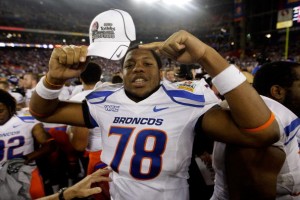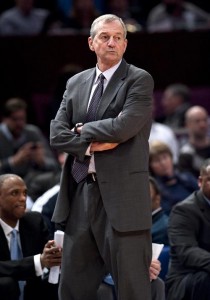Hey NCAA: You Are Changing the Wrong Championship!

If the NCAA Basketball Tournament expands, Northern Iowa would likely need to win two games before getting a chance at a top seed like Kansas.
I guess it is debatable as to whether sports were ever really about the fans, but in case you help out some naïve believe that fans mattered, you need look no further than decisions that are being made by the NCAA to realize that cash is king and everything else doesn’t really matter in today’s sports world.
Over the last several decades, football and basketball have developed into the marquee sports for college athletics. The Division I men’s basketball championship has evolved into “March Madness” and captivates millions of Americans in a three week love affair with office pools and Cinderella stories.
Few people like the current Division I college football championship structure of the Bowl Championship Series (BCS), but there is no denying the immense popularity of the sport.
A multitude of fans and critics have spent years calling for the NCAA to create a system for college football that is more like the playoff system used in college basketball and in football for all other divisions of college football.
Conversely, whenever it has been suggested that the NCAA basketball tournament might increase the number of teams, the debate is more divided with a majority seemly believing the status quo is working and adding to the field would cheapen the tournament and hurt the magic.
So, you can guess which championship looks like it will undergo some major revisions for next year.
Let me give you a hint, it isn’t the one that currently keeps most of the money with the “big boy” conferences.
Yes, in a greed play reminiscent of a robber going back into the bank because he forgot to take the bankers watch, the NCAA powers appear poised to increase the number of teams in the NCAA Basketball Tournament to 96.
[poll id=”87″]
This will make sure that top leagues like the Big East, Big 10 and SEC now get as many as 10 or 12 teams in the tournament in a given year and pretty much make sure that the likelihood of non-power conference teams like Butler and George Mason getting to the final four decreases even more than in the past.

The NCAA seems more concerned with giving a 9th place basketball team from the Big East a chance to play for a national title than it is to give an undefeated football team from Boise State the same chance.
So why would the NCAA change a tournament structure that over the last 25 years has been responsible for growing the tournament into the sports giant that it has become?
If you don’t know that answer then you haven’t been paying attention. It is of course, the ultimate four letter word: C-A-S-H.
By increasing the field to 96 teams, the NCAA can add an entire weekend of games to the tournament and thus extort even more money from CBS to maintain exclusive tournament rights. Or, more likely, it will force CBS to share the tournament with the deep-pocketed folks at ESPN.
While I’m not aware of a formal proposal for how the additional round will be played, the likely scenario is that the top 32 teams will get a first round by and the remaining 64 will play an extra round to reduce the field back to 64.
Though the first 32 games of the current tournament are played in just two days, watch for the NCAA to spread that round out over three or four days to give the most exposure and give the top 32 teams even more time off.
Then, after the big play-in weekend the new field of 64 would play the three week tournament that culminates with the Final Four.
While expanding the field would help some non-BCS leagues that are on the edge of deserving a second bid each year to have another team or two in the tournament, more than anything else the additional opportunities would allow for more schools from the power conferences to earn a spot in the field.
Instead of playing in the NIT, Connecticut, Virginia Tech, North Carolina and Illinois would be playing on the opening weekend of the tournament and likely getting the chance to play the winners from the conferences such as the Atlantic Sun, Northeast and American East.
Thus, instead of having a 64-team tournament that includes more than 20 teams from conferences that receive only one tournament bid, most of those schools would be eliminated in the first round and the 64-team tourney would include even more of the big boys.
So, in essence, the NCAA is much more concerned about ensuring that the 9th place team in the Big East (in 2010 South Florida with a 20-13 record and Seton Hall at 19-13 tied for 9th) gets a chance to play for the NCAA Basketball Championship than it is in trying to ensure that an undefeated football team from Utah or Boise State gets to play for the NCAA Football Championship.
While you can certainly argue that making this move helps the integrity of the field as a 16th seeded Illinois team would have a better chance against top-seeded Kansas or Kentucky than Prairie View A&M, I can’t help but think the new format would have some negative impact on the feel of the tournament.

Jim Calhoun's Connecticut team was 17-15 following the Big East Tournament, but would have probably earned an NCAA Tournament spot in the expanded field.
One of the attractions of the NCAA Tournament has always been that the small schools get a chance to play the big boys on a neutral court where anything can happen.
While no top seed has lost in the opening round of the tournament since it was expanded in 1985, there have been upsets of other high seeds in the opening round. In addition, Kansas this season became the latest example of a top seed losing to a non-power team in the opening weekend.
If the tournament is expanded next year, Northern Iowa would have needed to win two games before getting their crack at Kansas.
While we could debate all day whether the new format is good for the tournament and who gets the biggest benefit, the point is that because of money, the NCAA is likely adding another week to the basketball tournament (whatever happened to concerns over keeping the student-athletes out of class?) while doing absolutely nothing to address fans concerns about the college football championship.
Because of the deep pockets of the top bowl games and BCS conferences, the current system in college football is likely here to stay.
While many fans dislike the current system, coaches and administrators like it because it provides multiple opportunities for teams to end their season with a bowl appearance.
Of course, there are only so many bowls between teams with 6-6 records that I can handle, but it makes the schools feel like their season wasn’t a complete disappointment and ends the season on a positive note for players and coaches.
As I said in the opening, I’m not really sure if fans ever were part of the equation when it came to decision making in big-time sports. But I am very sure that in today’s culture the only part of a fan that major sports administrators (both college and pro) care about is their wallet.